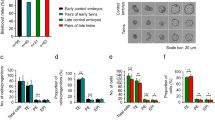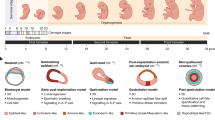Abstract
THE embryonic membrane antigen F9 has been detected on several lines of mouse embryonal carcinoma (EC) cells as well as on mouse embryos and sperm, but not on any other adult cells tested1. F9 or an antigenically similar substance has been demonstrated on the morula and/or sperm of several mammalian species2 including man3, but has been undetectable in all nonmammalian species tested2. Although no function for this antigen has been identified, its restriction to embryonic and germ cells suggests an important developmental role. This possibility is enhanced by the apparent conservation of F9 in the course of evolution. We now report the serological detection of F9 on human EC, together with our inability to detect β2 microglobulin.
This is a preview of subscription content, access via your institution
Access options
Subscribe to this journal
Receive 51 print issues and online access
$199.00 per year
only $3.90 per issue
Buy this article
- Purchase on Springer Link
- Instant access to full article PDF
Prices may be subject to local taxes which are calculated during checkout
Similar content being viewed by others
References
Artzt, K. et al. Proc. natn. Acad. Sci. U.S.A. 70, 2988 (1973).
Jacob, F. Immun. Rev. 33, 3 (1977).
Fellous, M., Gachelin, G., Buc-Caron, M. H., Dubois, P. & Jacob, F. Devl. Biol. 41, 331 (1975).
Fogh, J. & Trempe, G. in New Human Tumor Cell Lines (ed. Fogh, J.) 115–119 (Plenum, New York and London, 1975).
Bernstine, E. G., Hooper, M. L., Grandchamp, S. & Ephrussi, B. Proc. natn. Acad. Sci. U.S.A. 70, 3889 (1973).
Lillie, R. D. Histopathologic Technic and Practical Histochemistry 314 (McGraw-Hill, New York, 1965).
Artzt, K. & Jacob, F. Transplantation 17, 633 (1974).
Nicolas, J. F., Dubois, P., Jakob, H., Gaillard, J. & Jacob, F. A. Microbiol., Institut Pasteur 126 A, 3 (1975).
Schellhammer, P. F., Bracken, R. B., Bean, M. A., Pinsky, C. M. & Whitmore, W. F. Cancer 38, 149 (1976).
Jewett, M. A. S., Hadju, S. I., Good, R. A. & Whitmore, W. F. Br. J. Urol. 49, 335 (1977).
Forman, J. & Vitetta, E. S. Proc. natn. Acad. Sci. U.S.A. 72, 3661 (1975).
Zinckernagel, R. M. & Oldstone, M. B. Proc. natn. Acad. Sci. U.S.A. 73, 3666 (1976).
Doherty, P. C., Solter, D. & Knowles, B. B. Nature 266, 361 (1977).
Author information
Authors and Affiliations
Rights and permissions
About this article
Cite this article
HOLDEN, S., BERNARD, O., ARTZT, K. et al. Human and mouse embryonal carcinoma cells in culture share an embryonic antigen (F9). Nature 270, 518–520 (1977). https://doi.org/10.1038/270518a0
Received:
Accepted:
Issue Date:
DOI: https://doi.org/10.1038/270518a0
This article is cited by
-
The origins of human pluripotent stem cells: the road from a cancer to regenerative medicine
In Vitro Cellular & Developmental Biology - Animal (2024)
-
HLA-DR, DRw52.53, and DQ homozygosity in patients with neural tube defects
Japanese journal of human genetics (1987)
-
Teratocarcinoma: Basic research and its clinical relevance
World Journal of Urology (1984)
Comments
By submitting a comment you agree to abide by our Terms and Community Guidelines. If you find something abusive or that does not comply with our terms or guidelines please flag it as inappropriate.



